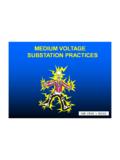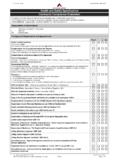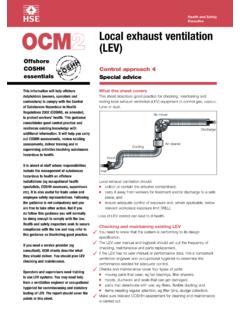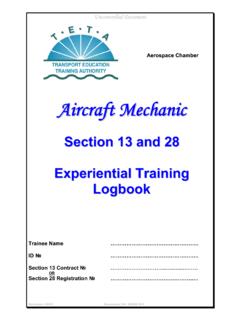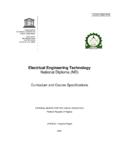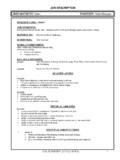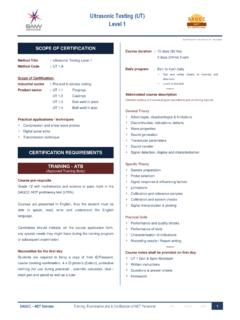Transcription of Clearing the air - hse.gov.uk
1 Health and Safety ExecutiveClearing the airA simple guide to buying and using local exhaust ventilation (LEV)1 of 9 pagesINDG408(rev1)Published 01/16 Every year, thousands of people in Great Britain die of lung disease or get asthma because of airborne contaminants they have breathed in at work. If your work produces dust (eg flour dust in bakeries), mist (eg paint mist from spraying), fume (eg from welding), gas (eg carbon monoxide from furnaces) or vapour (eg solvents from painting), there may be a risk to the health of your employees. This leaflet is aimed at employers or anyone who installs LEV. Many employers install LEV to protect their workers health but it doesn t always work effectively. It needs to be of the right type and properly installed, used and maintained. This leaflet advises on how to select the right LEV for your workplace and how to maintain it properly to help protect your employees.
2 What is LEV? LEV is an extract ventilation system that takes dusts, mists, gases, vapour or fumes out of the air so that they can t be breathed in. Properly designed LEV will: collect the air that contains the contaminants; make sure they are contained and taken away from people; clean the air (if necessary) and get rid of the contaminants safely. Why should I bother with LEV? The law says you must control the risks from hazardous substances (the Control of Substances Hazardous to Health Regulations (COSHH)). Installing LEV may help you to do this. However, beforehand, you should consider other options first where it s reasonably practicable to do so, such as: change your method of work so exposure to hazardous substances can no longer occur; substitute the material being used by something safer; reduce the size of the source; modify the process to reduce the duration or frequency of emission; reduce the number of employees involved with a process; apply simple controls, eg fitting lids to equipment.
3 For more information about other ways of eliminating or reducing airborne contamination at work look at HSE s COSHH webpages: Health and Safety Executive2 of 9 pagesClearing the air: A simple guide to buying and using local exhaust ventilation (LEV)HoodInletDuctingAir moverDischargeAir cleanerFigure 1 Common elements of a simple LEV systemWhat makes up an LEV system? A typical LEV system will have: Hood(s) to collect airborne contaminants at, or near, where they are created (the source).Ducts to carry the airborne contaminants away from the process. Air cleaner to filter and clean the extracted which must be the right size and type to deliver sufficient suck to the for the safe release of cleaned, extracted air into the LEV hood may be tiny and built into a hand-held tool or it may be large enough to walk into. Here are some examples. Figure 2 On-tool extraction soldering ironFigure 3 On-tool extraction hand sanderFigure 4 Fixed capturing hoodFigure 5 Moveable capturing hoodFigure 6 Small boothFigure 7 Walk-in booth How do I make sure I get the right type of LEV?
4 When LEV doesn t work as well as it should, a common reason is that the hood doesn t catch or contain the contaminants effectively. It is important to match the hood to the source that you want to control. There may be a standard, off-the-shelf system that would be suitable for you. However, it should be fit for purpose and capable of adequately controlling exposure. Health and Safety Executive3 of 9 pagesClearing the air: A simple guide to buying and using local exhaust ventilation (LEV)Ask your trade association or check industry guides. For example: woodworking machinery manufacturers may be able to provide or recommend volume flow rates (VFR) for LEV systems fitted to their machines. HSE has developed a free internet tool that provides practical advice on how to control risk of exposure (including information on LEV): If you have to make any changes to a standard system, or if there is no standard system for your industry, a clear specification will help you get what you need, and avoid any misunderstandings with the LEV supplier.
5 You can get help to write a specification of what you will need (see Useful links ).In developing a specification for your LEV: describe the process, the contaminant, its hazards and the sources to be controlled, and how stringent the control needs to be. The important chemical and flammable properties of substances and products appear in the safety data sheet; require indicators to be fitted to show that the system is working properly; require the LEV to be easy to use, check, maintain and clean, taking account of other risks, eg accessibility, skin contamination and waste removal and filter changing without spreading contamination; specify that the supplier provides training in how to use, check and maintain the LEV system; require the supplier to provide a user manual that describes and explains the LEV system, how to use, check, maintain and test it, along with performance benchmarks and schedules for replacing parts; require the supplier to provide a logbook for the system to record the results of checks and maintenance.
6 Talking to employees and/or their representatives about how your LEV will be used can provide useful information to consider when drawing up your specification. This will help ensure your LEV is both effective and this to your LEV supplier or to a ventilation engineer to design a system that will work for you. Installing LEV is rarely straightforward and mistakes can be costly; if you need further assistance developing your specification seek competent advice to help you select the right type of LEV (see Useful links ). How do I select an LEV supplier? You are responsible for making sure that your supplier is competent to define, design and install a suitable LEV system to meet the performance intended by design, and so selecting the right contractor is crucial. To help you do this, you may wish to: invite more than one tender; provide a drawing of the area and the processes to be controlled; provide your specification for the work to be done; tell potential contractors about any environmental or fire and explosion requirements; ask potential contractors to visit the site to see the processes.
7 Questions you may wish to ask potential suppliers: What experience do you have in designing and providing LEV systems? Health and Safety Executive4 of 9 pagesClearing the air: A simple guide to buying and using local exhaust ventilation (LEV) What are your professional qualifications, experience and memberships? To which industries have you supplied LEV? Have you successfully applied LEV to similar processes or activities in my industry? Can you provide references, testimonials or examples showing successful installation of LEV systems? Contact or, preferably, visit past customers to check references. Are you tied to a particular range of LEV products? How will you show that the LEV provides adequate control? What training do you include for using, checking and maintaining the LEV system? Only buy LEV that will adequately control exposure ask the supplier how they will prove this How do I know the LEV works?
8 Check the supplier s quotation covers all your requirements as laid out in your specification. On installation, the supplier should test the LEV to make sure it is working according to the specification. This is called commissioning and shows that it has been installed properly and that it controls exposure. This will need your co-operation because it should be done when normal working is taking place. You are responsible for ensuring your employees are trained and use the LEV correctly; ask the supplier how the LEV works and how to check and maintain it. Some suppliers may offer training. Key documents to expect from the supplier 1 A user manual with a general specification of what the LEV system is designed to control and how it achieves that control, including: a description of the system with diagrams; performance information from commissioning; a description of checks and maintenance and replacement schedules, including frequency; a listing of replaceable parts (and part numbers); a detailed description of the specific statutory thorough examination and test requirements and exposure targets; signs of wear and control failure; a description of how operators should use the system so it works effectively.
9 2 A logbook that includes: schedules for regular checks and maintenance; records of regular checks, maintenance, replacements and repairs; checks of compliance with the correct way of working with the LEV system; the name of the person who made these checks. 3 A commissioning report that includes: diagrams and a description of the LEV, including test points; details of the LEV performance specification; results, such as pressures and velocities at stated points; calculations; written descriptions of the commissioning, the tests undertaken and the outcome. Where necessary, this should include air sampling results; Health and Safety Executive5 of 9 pagesClearing the air: A simple guide to buying and using local exhaust ventilation (LEV) a description of how operators should use the system so it works effectively. A user manual, a logbook, a commissioning report and appropriate training will help you keep control.
10 If you don t have them, ask your LEV supplier for them What do I need to do once the LEV is installed? The law says that you need to make sure it carries on working properly. The user manual, logbook and training will help you do this. Most LEV systems need a thorough examination (see below) by a competent person and test once each year (legally, you are allowed no more than 14 months between tests) to make sure it works well and continues to protect your employees. Some LEV systems (such as those controlling more critical or high-hazard processes) need more frequent thorough examination and testing. COSHH requires more frequent testing for some processes. If you have an LEV system that hasn t been commissioned, you will need to have its performance tested to ensure that it is adequately controlling exposure. Checking and maintenance How often you check your LEV and how you do it will depend on how complicated the system is, how likely it is to fail, and the consequences if it does.











